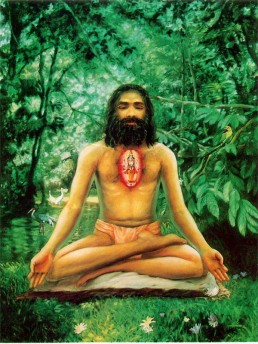Swami Chinmayananda
Swami Chinmayananda Commentary
However scientifically prepared it might be, to sit in an appropriate Asana (seat) is not, in itself, Yoga. The appropriate physical condition is conducive to generating the right mental attitude for the spiritual practices, but a mere physical posture cannot in itself, guarantee any spiritual self-development.
In this verse, Krishna is giving what the seeker should practise in his seat of meditation. Having made the body steadfast in posture, how one should employ his mind and intellect in the process of divine contemplation and meditation is the theme being discussed here. The first instruction given is that “YOU SHOULD MAKE THE MIND SINGLE-POINTED.” This instruction cannot be worked out by a seeker unless he knows how he can bring about this necessary inward condition in himself. It is very cheap and easy for a Rishi to advise the members of the confused generation to make their minds integrated.
Such an advice, when not sufficiently supported by practical details, becomes a mere high-sounding philosophy and not a useful guidance for the seekers. The Geeta, being a text-book which translates philosophy into life in its typical spirit, here the stanza immediately explains how we can bring the mind to an ideal single-pointedness.
SUBDUING THE FACULTY OF IMAGINATION AND THE ACTIVITIES OF THE SENSE-ORGANS — This is the instruction given by Krishna. Single-pointedness is the very potent nature of the mind but the mind gets stunned by its own silence, confused and even mad when it gets dynamised by either the inner forces of its own surging imaginations or the outward pull exerted by the hallucinations of the sense-organs. If these two venues of dissipation are blocked, instantaneously the mind becomes, by its own nature, single-pointed.
Thus, seated on the prepared meditation-seat, and making the mind single-pointed through the process of subduing mental imaginations and controlling the wild activities of the sense-organs, the seeker is encouraged to practise Yoga. To keep the single-pointed mind constantly at the steady contemplation of the Ultimate Self is the inner Yoga that has been mentioned here.
Naturally, every seeker would desire to know why he should meditate thus. In order to remove all mis-understandings of the meditators that they would thereby directly come face to face with the Atman, Krishna here appends to the verse the effects of such meditation. Through steady and regular meditation, the Shastra promises inner purification only. Agitations in the mind are its impurities. A purified mind is that which has no agitations and when the mind has thus become pure and steady, the Consciousness, looking at the steady reflection of Itself, comes to rediscover Its own Real Nature. This process is similar to the techniques by which we understand ourselves while consulting our own reflections in a mirror.
THE EXTERNAL SEAT HAS BEEN DESCRIBED. NOW, WHAT SHOULD BE THE POSTURE OF THE BODY? LISTEN:
Adi Sankara Commentary
Pratisthapya, having established; sthiram, firmly; sucau, in a clean; dese, place, which is solitary, either naturally or through improvement; atmanah, his own; asanam, seat; na ati ucchritam, neither too high; na ati nicam, nor even too low; and that made of caila-ajina-kusa-uttram, cloth, skin, and kusa-grass, placed successively one below the other-the successive arrangement of cloth etc. here is in a reverse order to that of the textual reading-. What follows after thus establishing the seat? Upavisya, sitting; tatra, on that; asane, seat; yogam yunjyat, he should concentrate his mind. To what purpose should he concentrate his mind? In answer the Lord says: atma-visuddhaye, for the purification of the internal organ. How? Krtva, making; manah, the mind; ekagram, one-pointed,by withdrawing it from all objects; and yata-citta-indriya-kriyah, keeping the actions (kriyah) of the mind (citta) and senses (indriya) under control (yata). The external seat has been spoken of. Now is being stated how the posture of the body should be:
The Bhagavad Gita with the commentary of Sri Sankaracharya – Translated by Alladi Mahadeva Sastry
Holy Geeta – Commentary by Swami Chinmayananda
The Bhagavad Gita by Eknath Easwaran – Best selling translation of the Bhagavad Gita
The Bhagavad Gita – Translation and Commentary by Swami Sivananda
Bhagavad Gita – Translation and Commentary by Bhaktivedanta Swami Prabupadha
Srimad Bhagavad Gita Chapter 6 – Verse 12 – 6.12 tatraikagram manah – All Bhagavad Gita (Geeta) Verses in Sanskrit, English, Transliteration, Word Meaning, Translation, Audio, Shankara Bhashya, Adi Sankaracharya Commentary and Links to Videos by Swami Chinmayananda and others – 6-12

